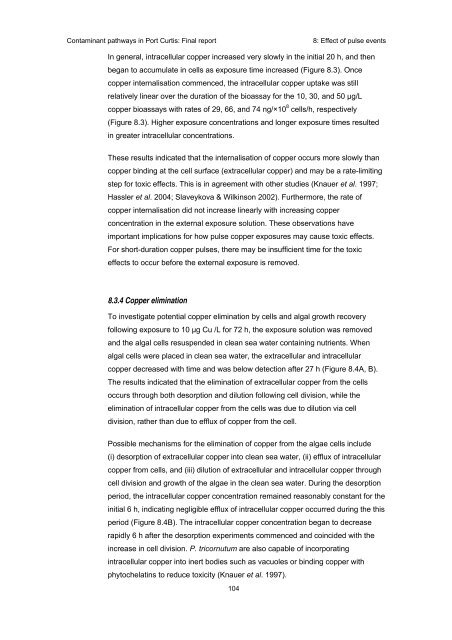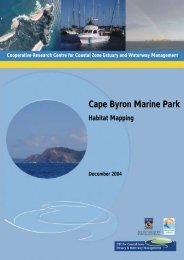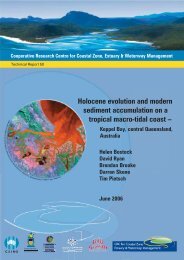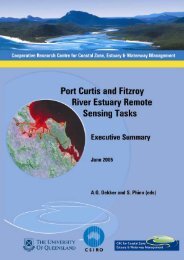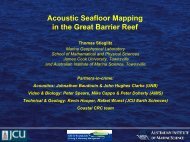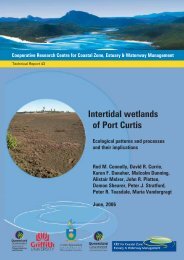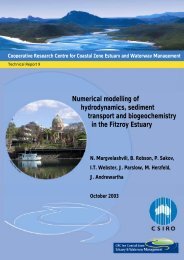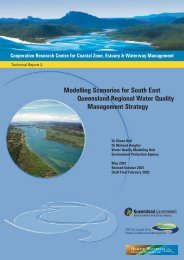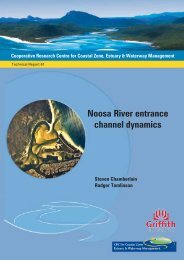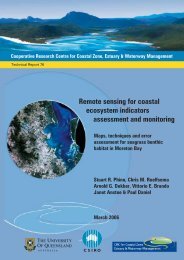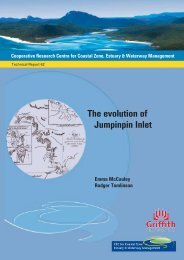Contaminant pathways in Port Curtis: Final report - OzCoasts
Contaminant pathways in Port Curtis: Final report - OzCoasts
Contaminant pathways in Port Curtis: Final report - OzCoasts
You also want an ePaper? Increase the reach of your titles
YUMPU automatically turns print PDFs into web optimized ePapers that Google loves.
<strong>Contam<strong>in</strong>ant</strong> <strong>pathways</strong> <strong>in</strong> <strong>Port</strong> <strong>Curtis</strong>: F<strong>in</strong>al <strong>report</strong>8: Effect of pulse eventsIn general, <strong>in</strong>tracellular copper <strong>in</strong>creased very slowly <strong>in</strong> the <strong>in</strong>itial 20 h, and thenbegan to accumulate <strong>in</strong> cells as exposure time <strong>in</strong>creased (Figure 8.3). Oncecopper <strong>in</strong>ternalisation commenced, the <strong>in</strong>tracellular copper uptake was stillrelatively l<strong>in</strong>ear over the duration of the bioassay for the 10, 30, and 50 µg/Lcopper bioassays with rates of 29, 66, and 74 ng/×10 8 cells/h, respectively(Figure 8.3). Higher exposure concentrations and longer exposure times resulted<strong>in</strong> greater <strong>in</strong>tracellular concentrations.These results <strong>in</strong>dicated that the <strong>in</strong>ternalisation of copper occurs more slowly thancopper b<strong>in</strong>d<strong>in</strong>g at the cell surface (extracellular copper) and may be a rate-limit<strong>in</strong>gstep for toxic effects. This is <strong>in</strong> agreement with other studies (Knauer et al. 1997;Hassler et al. 2004; Slaveykova & Wilk<strong>in</strong>son 2002). Furthermore, the rate ofcopper <strong>in</strong>ternalisation did not <strong>in</strong>crease l<strong>in</strong>early with <strong>in</strong>creas<strong>in</strong>g copperconcentration <strong>in</strong> the external exposure solution. These observations haveimportant implications for how pulse copper exposures may cause toxic effects.For short-duration copper pulses, there may be <strong>in</strong>sufficient time for the toxiceffects to occur before the external exposure is removed.8.3.4 Copper elim<strong>in</strong>ationTo <strong>in</strong>vestigate potential copper elim<strong>in</strong>ation by cells and algal growth recoveryfollow<strong>in</strong>g exposure to 10 µg Cu /L for 72 h, the exposure solution was removedand the algal cells resuspended <strong>in</strong> clean sea water conta<strong>in</strong><strong>in</strong>g nutrients. Whenalgal cells were placed <strong>in</strong> clean sea water, the extracellular and <strong>in</strong>tracellularcopper decreased with time and was below detection after 27 h (Figure 8.4A, B).The results <strong>in</strong>dicated that the elim<strong>in</strong>ation of extracellular copper from the cellsoccurs through both desorption and dilution follow<strong>in</strong>g cell division, while theelim<strong>in</strong>ation of <strong>in</strong>tracellular copper from the cells was due to dilution via celldivision, rather than due to efflux of copper from the cell.Possible mechanisms for the elim<strong>in</strong>ation of copper from the algae cells <strong>in</strong>clude(i) desorption of extracellular copper <strong>in</strong>to clean sea water, (ii) efflux of <strong>in</strong>tracellularcopper from cells, and (iii) dilution of extracellular and <strong>in</strong>tracellular copper throughcell division and growth of the algae <strong>in</strong> the clean sea water. Dur<strong>in</strong>g the desorptionperiod, the <strong>in</strong>tracellular copper concentration rema<strong>in</strong>ed reasonably constant for the<strong>in</strong>itial 6 h, <strong>in</strong>dicat<strong>in</strong>g negligible efflux of <strong>in</strong>tracellular copper occurred dur<strong>in</strong>g the thisperiod (Figure 8.4B). The <strong>in</strong>tracellular copper concentration began to decreaserapidly 6 h after the desorption experiments commenced and co<strong>in</strong>cided with the<strong>in</strong>crease <strong>in</strong> cell division. P. tricornutum are also capable of <strong>in</strong>corporat<strong>in</strong>g<strong>in</strong>tracellular copper <strong>in</strong>to <strong>in</strong>ert bodies such as vacuoles or b<strong>in</strong>d<strong>in</strong>g copper withphytochelat<strong>in</strong>s to reduce toxicity (Knauer et al. 1997).104


